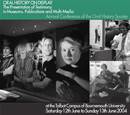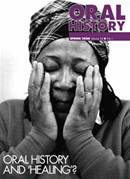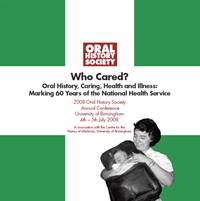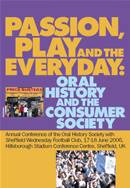

The making of oral history: Sections 7–9
Graham Smith
- Early history
- Developments in oral history theory
- Ethics and legal understanding
- Technical change and oral history
- Community oral history
- Archives
- Oral history as public history
- Applied oral history
- The future of oral history
- Footnotes
Oral history as public history
Public history even in recent years has been somewhat neglected in Britain, certainly in comparison to Australia and the United States. Oral historians have, however, been long interested in presenting their findings in publicly accessible formats.
In 1978 Oral History carried two pieces on oral history and broadcasting.(51) Since then there have been contributions about oral history on television, radio and film, and in museums and the arts. In 1997 Oral History established a regular Public History section, and in 2005 this contained an overview of public history and oral history.
Exhibitions and museums
For many oral historians the point was not simply to describe or even analyse the past, but rather to (re)present recollections in ways that would engage people in discussing the meaning of their recollections. This not only meant the presentation of analysed testimonies in academic publications, but also in ways and in forms that a broader public, including interviewees, could engage with. This was one interpretation of 'shared authority'.
In the 1980s community-based oral historians often presented their findings in exhibitions. Exhibitions offered a relatively inexpensive and easily accessible means of communication – typically combining photographs and extracts from interviews.
Tim Smith, of the Bradford Heritage Recording Unit, has been a leading exponent of this approach and has in a number of exhibitions and publications shown how effective the juxtaposition of text, photographs and graphics can be. As well as Bradford Museums, there are also important centres of museum oral history elsewhere including in Birmingham and Newcastle, and in Southampton at the Oral History Unit.

The oral history-based exhibition has been incorporated into museums across Britain. And in the 1990s audio and video extracts from recorded interviews were increasingly being added to exhibitions. Sound archives in museums, such as the one at Fagans in Wales, had been exceptional in the mid 20th century. However, establishing oral history archives has increasingly become a staple of museums' social history collections. See for example the Imperial War Museum.
The innovative use of technology in museums and galleries is making oral history ever more accessible to visitors. For example, the Tate Modern's multimedia tour (using PDAs) includes interviews with artists such as Joseph Beuys, Richard Hamilton, Louise Bourgeois and Fiona Rae.
And then there is the work of audio or sound artists such as Graeme Miller, Nye Parry and Kathy Lane who feature oral history in their installations. This work involves some of the most artistically innovative uses of oral history in public spaces.
A number of museums also began to work more closely with their publics through oral history projects. This included the People's Story Museum in Edinburgh and the Museum of London, which has also extended presentation to the World Wide Web; an excellent example of this is Belonging: Voices of London's Refugees.
Radio
Jill Liddington's historical survey of radio oral history (52) begins with the Radio Ballads. Together with Peggy Seeger and Ewan McCall (1915–89), Charles Parker (1918–80) produced eight Radio Ballads for the BBC between 1957 and 1964. These were based on long recordings with 'ordinary people' recalling their experiences. Included were the stories of boxers, fishermen, migrants, miners and construction workers.
The approach of combining recollections based on lengthy recordings with music would be taken up in the 1980s by Billy Kay for his BBC Radio Scotland series. One of the most prolific oral historians in Britain from the 1990s onwards has been Alan Dein. Dein's work has included Yemeni steel workers in Sheffield and the end of British rule in Aden.

Television
Television has made a significant contribution to the popularisation of oral history. Stephen Peet (1920–2005), mainly through his memorable work on the Yesterday's Witness series (1969–81), has been called the father of television oral history.(53)
For many, however, The Great War, first broadcast by the BBC in 1964 (re-released on DVD in 2002) is among the earliest examples of television oral history. And there were others who made significant contributions, including Philip Donnellan (1924–99). Then there was the widely acclaimed The World at War (1973, Thames) written by Charles Douglas-Home, produced by Jeremy Isaacs and directed by David Elstein.
Since the late 1980s it is the work of Steve Humphries (Testimony Films) that has consistently kept oral histories on television.
Digital and web-based
The internet offers new possibility to oral historians. And there are growing numbers of projects using the web in imaginative ways. This includes life histories and more topic-based or thematic approaches.
The Imperial War Museum has a fascinating collection of around 21,000 recordings. There are approximately 340 short extracts that can be listened to online. Indexed by keyword(s), nationality and name, the collection includes recorded memories of the First World War.
It has become common for oral history collections to present short extracts online. Extracts from Paul Thompson's 'Edwardians' interviews are available from the Economic and Social Data Service's Qualidata website, for example. Qualidata's approach to documenting oral history collections is especially interesting.
A number of smaller organisations also provide both transcripts and audio files. This includes, for example, the Diabetes Stories site, which contains audio recordings of the life stories of 50 people diagnosed with diabetes between 1927 and 1997.
The largest collection of oral histories in Britain is held by the British Library Sound Archive. The Archive has also led the way in making materials accessible online. An extensive index to its oral history collection is available online. But perhaps more significantly full life story interviews can be downloaded from their website following the Library's mass digitisation and web-access project.
In 2003 the British Library Sound Archive began systematically to extend its web presence. So, for example, The Way We Speak project presents over 650 comparative extracts from the Survey of English Dialects, collected between 1951 and 1961, with recordings made in the late 1990s as part of the Millennium Memory Bank.
A second digitisation for web access project followed between 2004 and 2006. This included over 3,000 hours of unmediated oral history interviews with artists, sculptors, photographers, architects, designers, jazz musicians and others. These recordings, and the details of many more, can be found through the Sound Archive catalogue at the British Library.
While there has been an increasing presence of oral history on the web, there are concerns that legal and ethical considerations have not kept pace. Rob Perks,(54) the British Library's Oral History Curator, along with colleagues at UCL undertook a survey of web-based oral history in 2005. The survey, along with web-access mass digitisation projects by the Library, has meant the rise of a range of new issues involving ethics, user impact and the way recordings are presented on the web.
Digitisation and the World Wide Web are throwing up challenges as well as opportunities for oral historians and archivists. With 'Web 2.0' will come new approaches involving social networking and perhaps the spread of e-oral history. An example of e-oral history can be found at the Hallam Centre for Community Justice's Centenary of Probation celebrations website.
Applied oral history
Reminiscence

If oral history is concerned about product, it is the process of memory that provides the rationale for reminiscence. Inspired by oral history, community publishing and developments in the psychology of old age in the 1960s and 1970s reminiscence began to emerge as a social movement.(55)
Help the Aged, through the Recall tape/slide pack, were among the early pioneers producing reminiscence materials. It was a format that was easily copied by local organisations, including museums. Such materials would in turn engage the imagination of paid staff and unpaid volunteers who were working with older people.
The result has been that there are reminiscence training courses, including those organised by Age Concern and Age Exchange. There have also been a number of attempts to measure efficacy of reminiscence as a therapeutic intervention.
Recent years have also witnessed the emergence of a European Reminiscence Network.
In Drama
The use of oral history in theatre has included productions by reminiscence groups, community organisations and political activist.
Pam Schweitzer's work, often in association with Age Exchange, is among the best known in the reminiscence theatre movement. Schweitzer has published on the nature, practice and therapeutic effects of reminiscence theatre.(56)
The Living Archive, Milton Keynes, have led the way in community productions. This has included the musical documentary play staged in 1996, Bigger Brighter Better, about Bletchley's post-war pioneers.
Oral history has been an important part of theatre work that intends to raise political consciousness. One example of which is OurStory Scotland's oral history initiatives. The lesbian, gay, bisexual and transgender (LGBT) charity linked up with 7:84 Theatre Company Scotland on an outreach project culminating in a performance at Glasgay, Scotland's annual celebration of queer culture.
See the oral history and theatre training course.
Informing policy
Oral history has also been used to inform policy in a number of different areas both internationally and nationally.
One example of utilising oral history to inform policy can be found in the work of London-based Panos. The organisation uses oral testimony and life histories to shape developmental policies in Pakistan, Namibia and Sudan.
And within Britain oral history has provided insights into an increasing variety of policy concerns. These range from the regulation of supermarkets,(57) through credit and debt in working class communities,(58) and to marginalised sexualities and ageing.(59)

Other oral historians have sought to gain a better understanding of the experiences of those who deliver and use a variety of services. In doing so they have argued that understanding past experiences can shape future practice.
Gaining the perspectives of clients and service users is especially evident in the history of health and illness. Among the myriad of individuals and projects engaged in this work are the Learning Disability History Research Group and the Hospice History Programme.
Such approaches can generate heated debate about the purpose of history, as was the case in 1999 when members of the charity Mind asked, 'Whose story is it anyway?'(60)
The future of oral history
There are a number of challenges and opportunities facing the Oral History Society. These include responding to the rapid growth of oral history, and continuing to support community oral history while maintaining academic oral history at the same time.
The spread of oral history from the 1990s onwards has been extraordinary. Some oral historians have questioned whether the popularisation of oral history has meant a loss of radicalism and innovation. Oral history could also be seen as contributing to individualisation. On the other hand such developments within oral history may simply be reflecting the period of historical reaction that we are currently living through.
The turn towards 'narrative' in the social sciences and the increase in 'memory' studies across the arts and sciences offers oral historians new opportunities. And an important task for oral historians is to engage with narrative and memory work, and by doing so gain important allies that can sustain and further develop oral history.
A core group of individuals, both community- and university-based, would describe themselves as oral historians. However, most oral history is probably practised either in one-off initiatives or as a supplementary method. The Oral History Society has always had a proportion of short-term members. This has tended to be viewed negatively. However, it may be that such involvement has assisted in spreading an understanding of oral history more widely than would otherwise have been the case. Certainly the current leadership of the Society has continued to oppose oral history becoming the preserve of a narrow, self-serving professional grouping.
Oral historians who work in community settings find themselves driven by a number of concerns and debates. For those employed under the Heritage Lottery Fund the contribution that recorded memories can make to heritage and popular understandings of the past is a major challenge. Similarly, for those in local authority-funded museums and archives the popularity of recalling and listening to recollections of the past remain significant. It is about how the keepers of our past can connect to new audiences and find new ways of interpreting and presenting the past that is important.

The number of oral historians in British universities is relatively small. And oral historians tend to spread throughout university departments, including sociology, health and social care, politics and, occasionally, in history. Like other academics they keep their jobs by publishing in academic journals and winning funding from research councils. However, this means that there is a lack of critical mass, both in numbers and concentration. This in turn results in 'peer review' processes that decide on grants and publications invariably involving non-oral historians, who may not be informed about or sympathetic towards oral history.
While these two broad approaches do overlap and have a great deal in common, there are tensions between them that arise at least in part from differences in the underpinning material conditions. This tension between the community and academic wings of the oral history movement will continue to be the source for a range of debates.
Graham Smith is Chair of the Oral History Society and a Senior Lecturer at Royal Holloway University London.


